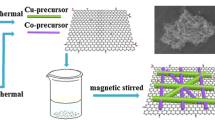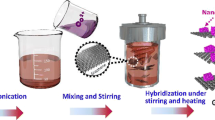Abstract
The Co3O4@rGO derived from metal–organic frameworks (MOFs) were prepared by a simple solvothermal method followed by the heat treatment. In a typical preparation process, the Co-MOF (ZIF-67) acts as the precursor to obtain desirable nano Co3O4 while the reduced graphene oxide (rGO) layer enhances the conductivity. The materials were respectively characterized by XRD, SEM, and then further electrochemical tests. As anode materials for lithium-ion batteries (LIBs), the material of Co3O4@rGO exhibit overall superb electrochemical properties especially when the rGO proportion is 20%, it displays higher capacity (818.5 mAh g−1 at 100 mA g−1), higher cycling stability (87.3% capacity retention after 100 cycles), and better rate performance. The work may throw some lights on the preparation of other transition metal oxides by structure design with rGO layer for further applications.
Graphical abstract







Similar content being viewed by others
References
Tarascon JM, Armand M (2001) Issues and challenges facing rechargeable lithium batteries. Nature 414:359–367. https://doi.org/10.1038/35104644
Lou XW, Deng D, Lee JY, Feng J, Archer LA (2007) Self-supported formation of needlelike Co3O4 nanotubes and their application as lithium-ion battery electrodes. Adv Mater 20:258–262. https://doi.org/10.1002/adma.200702412
Pei MC, Qi ZQ, Wu YD, Mei DQ, Wen SG (2021) Facile synthesis and electrochemical performance of a copper-doped anode material Cu0.5Ni0.5Co2O4 for lithium-ion batteries. Ionics 27:2803–2812. https://doi.org/10.1007/s11581-021-04066-1
Wei T, Zhang ZH, Zhu ZY, Zhou XP, Wang YY, Wang YZ, Zhuang QC (2019) Batch-scale synthesis of porous zinc manganese oxide with large specific surface area for Li-ion battery anodes. Ionics 25:1523–1529. https://doi.org/10.1007/s11581-019-02892-y
Teranishi T, Wachi A, Kanehara M, Shoji T, Sakuma N, Nakaya M (2008) Conversion of anisotropically phase-segregated Pd/γ-Fe2O3 nanoparticles into exchange-coupled fct-FePd/α-Fe Nanocomposite Magnets. J Am Chem Soc 130:4210–4211. https://doi.org/10.1021/ja077921v
Liu MT, Hou XY, Wang T, Ma YD, Sun K, Liu DQ, Wang YR, He DY, Li JS (2018) Rapid activation and enhanced cycling stability of Co3O4 microspheres decorated by N-doped amorphous carbon shell for advanced LIBs. Electrochim Acta 283:979–986. https://doi.org/10.1016/j.electacta.2018.07.021
Huang Y, Yao JH, Zheng YY, Huang RS, Li YW (2019) A simple preparation of rod-like Fe2O3 with superior lithium storage performance. Mater Lett 234:105–108. https://doi.org/10.1016/j.matlet.2018.09.080
Zhang YC, Wang RZ, Zheng Z, Li T, Tong ZQ, Ai CC (2020) Fluorine-doped SnO2/reduced graphene oxide-artificial graphite hybrids as lithium-ion battery anodes with stable capacity. Ionics 26:2835–2843. https://doi.org/10.1007/s11581-020-03493-w
Lin YD, Kang HF, Liang MX, Ye XX, Li JX, Feng Q, Zheng YP, Huang ZG (2020) Hybrid nanostructured MnO2 nanowire/graphdiyne with enhanced lithium-ion performance promoting by interfacial storage. Appl Surf Sci 526:146457. https://doi.org/10.1016/j.apsusc.2020.146457
Li WY, Deng LY, Wang XH, Cao JQ, Xie YH, Zhang QL, Zhang H, Deng H, Cheng SY (2021) Close-spaced thermally evaporated 3D Sb2Se3 film for high-rate and high-capacity lithium-ion storage. Nanoscale 13:9834–9842. https://doi.org/10.1039/D1NR01585K
Deng LY, Li WY, Li HN, Cai WF, Wang JY, Zhang H, Jia HJ, Wang XH, Cheng SY (2020) A hierarchical copper oxide–germanium hybrid film for high areal capacity lithium ion batteries. Front Chem 7:869. https://doi.org/10.3389/fchem.2019.00869
Wang ZR, Gao QB, Lv P, Li XW, Wang XH, Qu BH (2020) Facile fabrication of core-shell Ni3Se2/Ni nanofoams composites for lithium ion battery anodes. J Mater Sci Tech 38:119–124. https://doi.org/10.1016/j.jmst.2019.08.021
Wang GY, Zhang M, Deng ZP, Zhang XF, Huo LH, Gao S (2020) Poplar branch bio-template synthesis of mesoporous hollow Co3O4 hierarchical architecture as an anode for long-life lithium ion batteries. Ceram Int 46:29033–29040. https://doi.org/10.1016/j.ceramint.2020.08.074
Du W, Bai YL, Xu JQ, Zhao HB, Zhang L, Li XF, Zhang JJ (2018) Advanced metal-organic frameworks (MOFs) and their derived electrode materials for supercapacitors. J Power Sources 402:281–295. https://doi.org/10.1016/j.jpowsour.2018.09.023
Shrivastav V, Sundriyal S, Goel P, Kaur H, Tuteja SK, Vikrant K, Kim KH, Tiwari UK, Deep A (2019) Metal-organic frameworks (MOFs) and their composites as electrodes for lithium battery applications: novel means for alternative energy storage. Coord Chem Rev 393:48–78. https://doi.org/10.1016/j.ccr.2019.05.006
Yin XM, Li HJ, Yuan RM, Lu JH (2021) NiCoLDH nanosheets grown on MOF-derived Co3O4 triangle nanosheet arrays for high-performance supercapacitor. J Mater Sci Tech 62:60–69. https://doi.org/10.1016/j.jmst.2020.05.066
Huang YF, Sun XY, Huo SH, Li Y, Zhong CL (2019) Core-shell dual-MOF heterostructures derived magnetic CoFe2O4/CuO-microcages with superior catalytic performance. Appl Surf Sci 466:637–646. https://doi.org/10.1016/j.apsusc.2018.10.074
Zhang YN, Li B, Fu L, Li Q, Yin LW (2020) MOF-derived ZnO as electron transport layer for improving light harvesting and electron extraction efficiency in perovskite solar cells. Electrochim Acta 330:135280. https://doi.org/10.1016/j.electacta.2019.135280
Yang HL, Shen ZJ, Peng HL, Xiong ZQ, Liu CB, Xie Y (2021) 1D–3D mixed-dimensional MnO2@nanoporous carbon composites derived from Mn-metal organic framework with full-band ultra-strong microwave absorption response. Chem Eng J 417:128087. https://doi.org/10.1016/j.cej.2020.128087
Zheng FC, Wei LZ (2019) Synthesis of ultrafine Co3O4 nanoparticles encapsulated in nitrogen-doped porous carbon matrix as anodes for stable and long-life lithium ion battery. J Alloys Compd 790:955–962. https://doi.org/10.1016/j.jallcom.2019.03.212
Kurc B, Pigłowska M (2021) An influence of temperature on the lithium ions behavior for starch-based carbon compared to graphene anode for LIBs by the electrochemical impedance spectroscopy (EIS). J Power Sources 485:229323. https://doi.org/10.1016/j.jpowsour.2020.229323
Tian S, Wang YS, Cai TH, Kong DQ, Wang DD, Ren H, Xing W (2020) Polyaniline-derived carbon nanotubes as anode materials for potassium-ion batteries: insight into the effect of N-doping. Appl Surf Sci 534:147635. https://doi.org/10.1016/j.apsusc.2020.147635
Wan HR, Ju XZ, He TT, Chen T, Zhou YM, Zhang C, Wang JM, Xu Y, Yao B, Zhuang WC, Du XH (2021) Sulfur-doped porous carbon as high-capacity anodes for lithium and sodium ions batteries. J Alloys Compd 863:158078. https://doi.org/10.1016/j.jallcom.2020.158078
Zhang WJ, Wang YX, Guo XL, Liu YY, Zheng YM, Zhang M, Li R, Peng ZB, Wang ZM, Zhang T (2021) High performance Bi2O2CO3/rGO electrode material for asymmetric solid-state supercapacitor application. J Alloys Compd 855:157394. https://doi.org/10.1016/j.jallcom.2020.157394
Islam MS, Faisal SN, Tong LY, Roy AK, Zhang J, Haque E, Minett AI, Wang CH (2021) N-doped reduced graphene oxide (rGO) wrapped carbon microfibers as binder-free electrodes for flexible fibre supercapacitors and sodium-ion batteries. J Energy Storage 37:102453. https://doi.org/10.1016/j.est.2021.102453
Zhang R, Dong YT, Al-Tahan MA, Zhang YY, Wei RP, Ma YH, Yang CC, Zhang JM (2021) Insights into the sandwich-like ultrathin Ni-doped MoS2/rGO hybrid as effective sulfur hosts with excellent adsorption and electrocatalysis effects for lithium-sulfur batteries. J Energ Chem 60:85–94. https://doi.org/10.1016/j.jechem.2021.01.004
Yang ZW, Huang Y, Yao FL, Luo HL, Wan YZ (2018) Wrapping mesoporous Fe2O3 nanoparticles by reduced graphene oxide: enhancement of cycling stability and capacity of lithium ion batteries by mesoscopic engineering. Ceram Int 44:20656–20663. https://doi.org/10.1016/j.ceramint.2018.08.058
Huang Q, Wei T, Zhang M, Dong LZ, Zhang AM, Li SL, Liu WJ, Liu J, Lan YQ (2017) A highly stable polyoxometalate-based metal–organic framework with π–π stacking for enhancing lithium ion battery performance. J Mater Chem A 5:8477–8483. https://doi.org/10.1039/c7ta00900c
Wei T, Zhang ZH, Wang ZM, Zhang Q, Ye YS, Lu JH, Rahman ZU, Zhang ZW (2020) Ultrathin solid composite electrolyte based on Li6.4La3Zr1.4Ta0.6O12/PVDF-HFP/LiTFSI/Succinonitrile for high-performance solid-state lithium metal batteries. ACS Appl Energy Mater 3:9428–9435. https://doi.org/10.1021/acsaem.0c01872
Wei T, Zhang M, Wu P, Tang YJ, Li SL, Shen FC, Wang XL, Zhou XP, Lan YQ (2017) POM-based metal-organic framework/reduced graphene oxide nanocomposites with hybrid behavior of battery-supercapacitor for superior lithium storage. Nano Energy 34:205–214. https://doi.org/10.1016/j.nanoen.2017.02.028
Yang XY, Wei T, Li JS, Sheng N, Zhu PP, Sha JQ, Wang T, Lan YQ (2017) Polyoxometalate-incorporated metallapillararene/metallacalixarene metal-organic frameworks as anode materials for lithium ion batteries. Inorg Chem 56:8311–8318. https://doi.org/10.1021/acs.inorgchem.7b00995
Zhang M, Wei T, Zhang AM, Li SL, Shen FC, Dong LZ, Li DS, Lan YQ (2017) Polyoxomolybdate-polypyrrole/reduced graphene oxide nanocomposite as high-capacity electrodes for lithium storage. ACS Omega 2:5684–5690. https://doi.org/10.1021/acsomega.7b00752
Yang XL, Ye YS, Wang ZM, Zhang ZH, Zhao YL, Yang F, Zhu ZY, Wei T (2020) POM-based MOF-derived Co3O4/CoMoO4 nanohybrids as anodes for high-performance lithium-ion batteries. ACS Omega 5:26230–26236. https://doi.org/10.1021/acsomega.0c03929
Zhang ZH, Wei T, Lu JH, Xiong QM, Ji YH, Zhu ZY, Zhang LT (2021) Practical development and challenges of garnet-structured Li7La3Zr2O12 electrolytes for all solid-state lithium-ion battery—a review. Int J Miner Metall Mater. https://doi.org/10.1007/s12613-020-2239-1
Wei T, Zhang ZH, Zhang Q, Lu JH, Xiong QM, Wang FY, Zhou XP, Zhao WJ, Qiu XY (2021) Anion-immobilized solid composite electrolytes based on metal-organic frameworks and superacid ZrO2 fillers for high-performance all solid-state lithium metal batteries. Int J Miner Metall Mater. https://doi.org/10.1007/s12613-021-2289-z
Zhang S, Shao YY, Liao HG, Engelhard MH, Yin GP, Lin YH (2011) Polyelectrolyte-induced reduction of exfoliated graphite oxide: a facile route to synthesis of soluble graphene nanosheets. ACS Nano 5:1785–1791. https://doi.org/10.1021/nn102467s
Shao YY, Wang J, Engelhard M, Wang CM, Lin YH (2010) Facile and controllable electrochemical reduction of graphene oxide and its applications. J Mater Chem 20:743–748. https://doi.org/10.1039/B917975E
Guo P, Song HH, Chen XH (2009) Electrochemical performance of graphene nanosheets as anode material for lithium-ion batteries. Electrochem Commun 11:1320–1324. https://doi.org/10.1016/j.elecom.2009.04.036
Tian LL, Zhuang QC, Li J, Wu C, Shi YL, Sun SG (2012) The production of self-assembled Fe2O3–graphene hybrid materials by a hydrothermal process for improved Li-cycling. Electrochim Acta 65:153–158. https://doi.org/10.1016/j.electacta.2012.01.034
Tian LL, Zhuang QC, Li J, Shi YL, Chen JP, Lu F, Sun SG (2011) Mechanism of intercalation and deintercalation of lithium ions in graphene nanosheets. Chin Sci Bull 56:3204–3212. https://doi.org/10.1007/s11434-011-4609-6
Li C, Chen TQ, Xu WJ, Lou XB, Pan LK, Chen Q, Hu BW (2015) Mesoporous nanostructured Co3O4 derived from MOF template: a high-performance anode material for lithium-ion batteries. J Mater Chem A 3:5585–5591. https://doi.org/10.1039/C4TA06914E
Zheng FC, Xia GL, Yang Y, Chen QW (2015) MOF-derived ultrafine MnO nano- crystals embedded in a porous carbon matrix as high-performance anodes for lithium-ion batteries. Nanoscale 7:9637–9645. https://doi.org/10.1039/C5NR00528K
Acknowledgements
This work was financially supported by the National Natural Science Foundation of China (No. 21701083), the Postgraduate Research and Practice Innovation Program of Jiangsu Province (Grant No. KYCX20_3137), and the Project of Jiangsu University (High-Tech Ship) Collaborative Innovation Center (2019, 1174871801-11).
Author information
Authors and Affiliations
Corresponding author
Additional information
Publisher’s note
Springer Nature remains neutral with regard to jurisdictional claims in published maps and institutional affiliations.
Rights and permissions
About this article
Cite this article
Wang, F., Ye, Y., Wang, Z. et al. MOF-derived Co3O4@rGO nanocomposites as anodes for high-performance lithium-ion batteries. Ionics 27, 4197–4204 (2021). https://doi.org/10.1007/s11581-021-04225-4
Received:
Revised:
Accepted:
Published:
Issue Date:
DOI: https://doi.org/10.1007/s11581-021-04225-4




